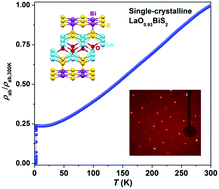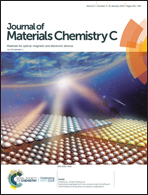Superconductivity and structural instability in layered BiS2-based LaO1−xBiS2†
Abstract
The exploration of new superconductors is always an unremitting work for researchers. The recent discovery of superconductivity in layered BiS2-based materials is important progress. Except for superconducting properties, the structure is a key point to debate at present. Here, we have synthesized polycrystalline and single crystalline LaO1−xBiS2 superconducting samples. It has been found that the semiconductor behavior of the parent phase LaOBiS2 was suppressed by oxygen vacancies, and a semiconductor–metal transition in the normal state was observed. The highest superconducting transition temperature reaches 3.2 K. Single-crystal X-ray diffraction analysis indicates that three different structures coexisted in the same batch of crystals, including tetragonal, monoclinic and triclinic structures. The present work shows that the introduction of oxygen vacancies is an alternative approach to induce superconductivity in the LaOBiS2 system and the structural instability is observed experimentally.



 Please wait while we load your content...
Please wait while we load your content...